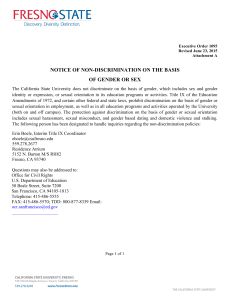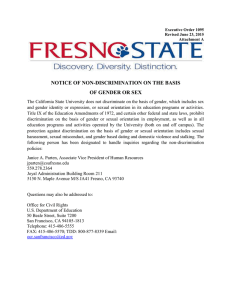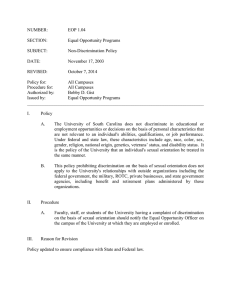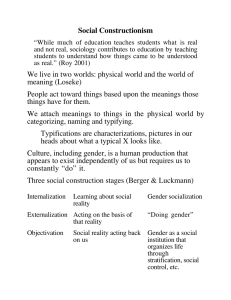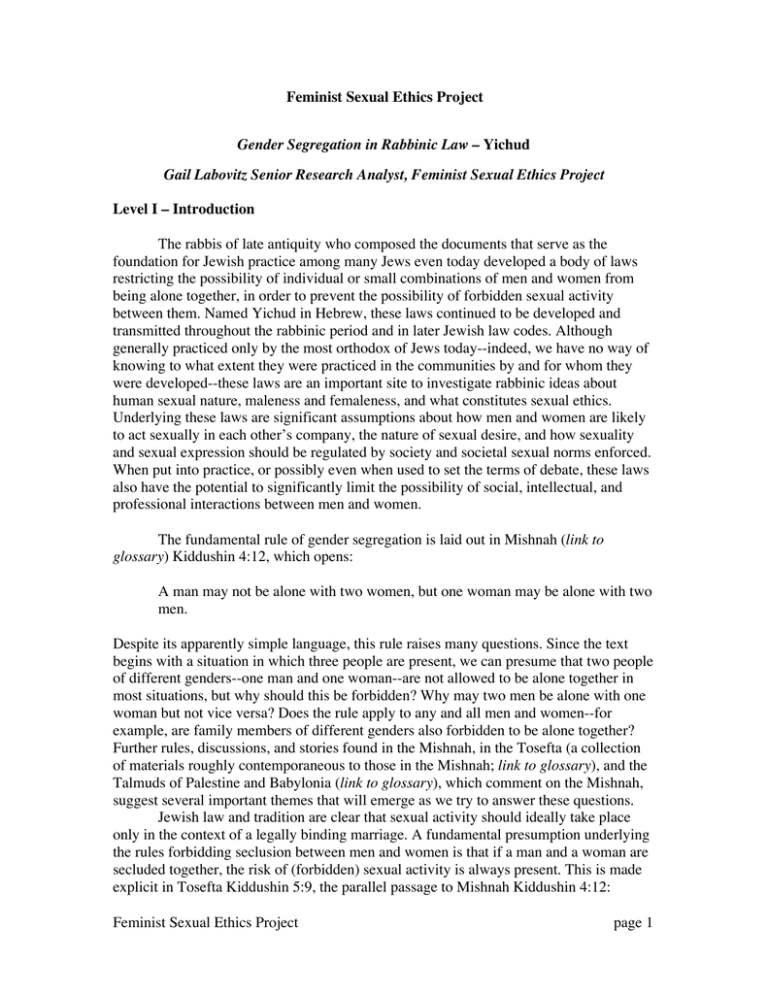
Feminist Sexual Ethics Project
Gender Segregation in Rabbinic Law – Yichud
Gail Labovitz Senior Research Analyst, Feminist Sexual Ethics Project
Level I – Introduction
The rabbis of late antiquity who composed the documents that serve as the
foundation for Jewish practice among many Jews even today developed a body of laws
restricting the possibility of individual or small combinations of men and women from
being alone together, in order to prevent the possibility of forbidden sexual activity
between them. Named Yichud in Hebrew, these laws continued to be developed and
transmitted throughout the rabbinic period and in later Jewish law codes. Although
generally practiced only by the most orthodox of Jews today--indeed, we have no way of
knowing to what extent they were practiced in the communities by and for whom they
were developed--these laws are an important site to investigate rabbinic ideas about
human sexual nature, maleness and femaleness, and what constitutes sexual ethics.
Underlying these laws are significant assumptions about how men and women are likely
to act sexually in each other’s company, the nature of sexual desire, and how sexuality
and sexual expression should be regulated by society and societal sexual norms enforced.
When put into practice, or possibly even when used to set the terms of debate, these laws
also have the potential to significantly limit the possibility of social, intellectual, and
professional interactions between men and women.
The fundamental rule of gender segregation is laid out in Mishnah (link to
glossary) Kiddushin 4:12, which opens:
A man may not be alone with two women, but one woman may be alone with two
men.
Despite its apparently simple language, this rule raises many questions. Since the text
begins with a situation in which three people are present, we can presume that two people
of different genders--one man and one woman--are not allowed to be alone together in
most situations, but why should this be forbidden? Why may two men be alone with one
woman but not vice versa? Does the rule apply to any and all men and women--for
example, are family members of different genders also forbidden to be alone together?
Further rules, discussions, and stories found in the Mishnah, in the Tosefta (a collection
of materials roughly contemporaneous to those in the Mishnah; link to glossary), and the
Talmuds of Palestine and Babylonia (link to glossary), which comment on the Mishnah,
suggest several important themes that will emerge as we try to answer these questions.
Jewish law and tradition are clear that sexual activity should ideally take place
only in the context of a legally binding marriage. A fundamental presumption underlying
the rules forbidding seclusion between men and women is that if a man and a woman are
secluded together, the risk of (forbidden) sexual activity is always present. This is made
explicit in Tosefta Kiddushin 5:9, the parallel passage to Mishnah Kiddushin 4:12:
Feminist Sexual Ethics Project
page 1
A woman may be alone with two men, even if both of them are Samaritans, even
if both of them are slaves, even if one is a Samaritan and one is a slave, except if
one is a minor, because she is not ashamed to engage in sexual intercourse before
him.
Underlying the mishnaic rule and subsequent elaborations of it, then, is an assumption
that sexual desire (whether it is male desire for female, vice versa, or both) is always
present when men and women are together, and moreover that where sexual temptation is
present, the likelihood of it leading to sexual activity is very high. Therefore, to prevent
forbidden sexual activity, sexual temptation should be reduced as much as possible--and
in the rabbinic mindset, only keeping individual men and women separate can achieve
this goal.
One significant presupposition guiding these laws that should be immediately
obvious is the rabbinic expectation that normal and normative sexual desire is
heterosexual--men desire women and women desire men. Rabbinic texts, beginning with
the Mishnah (Kiddushin 4:14), briefly consider the possibility of forbidden sexual
activity occurring between (Jewish) men, only to reject it:
Rabbi Yehudah says: An unmarried man may not herd animals, and two
unmarried men may not sleep in one cloak. But the Sages [i.e., the majority of the
early rabbis] permit (this).
The parallel passage in the Tosefta, Kiddushin 5:10 (and very similar versions of this
tradition, which are cited in both Talmuds in their commentary to this mishnah-Palestinian Talmud Kiddushin 4:11, 66c, and Babylonian Talmud Kiddushin 82a), further
specifies the reasoning behind the Sages’ view:
Rabbi Yuda (Yehudah) says: An unmarried man may not herd small animals (i.e.,
sheep, goats, etc.), and two unmarried men may not sleep in one cloak. But the
Sages say (the People of) Israel are not suspected of this.
The Sages--who appear in these passages anonymously and collectively, which is often a
way of indicating a normative, majority opinion in rabbinic writings--refuse to admit the
possibility that Israelite men will commit such an act. By refusing to legislate
“protection” against the possibility of two men being tempted to commit a sexual act,
they are suggesting that Israelite men rarely desire to commit such an act.
Indeed, so powerful and pervasive is heterosexual desire between men and
women in the rabbinic mindset that even social norms against incest cannot be relied
upon to inhibit it or its expression. Mishnah Kiddushin 4:12, for example, legislates that
parents and children of opposite genders may be alone together and even sleep in bodily
contact, but only until the child “becomes grown,” at which point each must sleep
clothed. The two Talmuds (Palestinian Talmud Kiddushin 4:11, 66c; Babylonian Talmud
Kiddushin 81b) offer several different views as to what age is meant, ranging from the
age of thirteen for a boy and twelve for a girl (the ages of legal majority in rabbinic
legislation, when one becomes bound to observe religious and social law and liable to
Feminist Sexual Ethics Project
page 2
punishment for violations), through physical puberty whenever it occurs, down to as
young as nine for a boy and three for a girl. Moreover, the Tosefta, Kiddushin 5:10
suggests that seclusion with all forbidden relations of the other gender, which would
presumably include one’s parent or one’s child, should be restricted:
His sister and his mother-in-law, and all the other relations forbidden (by the laws
of incest) in the Torah--he may not be alone with them except in the presence of
two (other people).
The Babylonian Talmud in particular (Kiddushin 81b) takes up this apparent
contradiction and suggests that rabbis continued to debate this topic:
Rav Yehudah said, Rav Assi said: A man may be alone with his sister, and he
may live with his mother and (or) with his daughter. When (someone) said this
before Shmu’el, he said: It is forbidden to be alone with all the forbidden relations
(listed) in the Torah…
What these discussions suggest is that in rabbinic thinking about sexuality, there was a
good deal of concern that neither age nor familial relationship would serve to
significantly inhibit sexual desire between male and female.
However, the gender imbalance in the basic rule of “yichud”--that is, that one
woman may be alone with two men but not two women with one man--also suggests that
the rabbis believed that men and women experienced and/or acted on their sexual desires
in different ways. Tosefta Kiddushin 5:9, cited above, provides a hint as to rabbinic
assumptions about how male and female experience and expression of sexual desire
differ, and thus need to be regulated differently, when it claims that a woman will not be
restrained from participating in sexual activity by the presence of a child. Women,
according to the toseftan passage, are less inhibited by shame or fear of sin than men, and
they will engage in forbidden sexual activity even in the presence of a third party. Two
men (even men who are on the margins of rabbinic society, such as Samaritans and
slaves), however, do feel shame and thus inhibit each other.
The Babylonian Talmud--Kiddushin 80b--briefly picks up this theme when it
opens its commentary to the Mishnah with the following:
What is the reason? It was taught by the school of Eliahu: Women are lightheaded.
The claim that women are “light-headed” appears in one other location in the Talmud
Shabbat 33b; in that passage the phrase is used to claim that women are unable to
withstand torture. Most likely, what is being suggested here is that women are generally
more weak-willed than men, including, but not limited to, a greater susceptibility to
sexual inducements. The bulk of the talmudic discussion, however, both Palestinian and
Babylonian, about the laws of seclusion, focus on rabbinic perceptions of male sexuality -not surprising, perhaps, for a literature created by men and for men and decidedly
androcentric in its approach. Both texts (Palestinian Talmud Kiddushin 4:11, 66c;
Babylonian Talmud Kiddushin 80a-81b) thus qualify the initial mishnaic law that two
Feminist Sexual Ethics Project
page 3
men may be alone with one woman, ruling that this is only the case when the men
involved are “kosher,” or “proper” men. In the case of morally unrestrained men,
however, even ten or one hundred may not be alone with one woman. The Babylonian
Talmud, moreover, proceeds in its extended discussion to cast doubts as to whether any
but the most extraordinary and pious of men can be considered “kosher”; the very rabbi
who is said to introduce the distinction between proper and morally unrestrained men
excludes himself and his student/colleague from the former category. A series of stories
which follow describe learned and pious rabbis who are not immune to experiencing, and
more importantly, acting on sexual desire in the presence of women. The Babylonian
Talmud in particular thus develops an image of male heterosexual desire as ever present,
overwhelming, and nearly irresistible.
Some scholars have argued that the laws prohibiting close contact between men
and women serve as a means of protecting women. If we read this way, however, we are
assuming, with the rabbis, that men are by nature sexually aggressive and/or unable to
resist acting upon their sexual urges. Instead, we need to question the assumptions on
which the laws are built and the rabbis’ perceptions of how men and women (and only
men and women) react sexually to each other. When we do this, we are then able to ask
what other social ends these laws might achieve. When one more or less consciously
accepts the rabbis’ assumptions and holds them in mind while reading these texts, the
obvious conclusion to which one would be led is to the masculine need for a society
almost entirely segregated by gender in labor and in daily life. As Mishnah Kiddushin
4:14 specifies at the conclusion of its discussion of this topic:
Anyone whose occupation is with women (i.e., brings him into regular contact
with women) may not be alone with the women. And a man should not teach his
son a trade among (i.e., practiced by and/or involving regular contact with)
women.
The Babylonian Talmud (Kiddushin 82b) adds a brief suggestion that men who do work
in occupations that bring them into regular contact with women can be presumed to be of
bad character. It is best, in the rabbinic mindset, that men limit as much as possible their
dealings with women in the workplace and elsewhere. The result is to limit the social
interactions and vocational options considered appropriate for both genders. In particular,
women will be kept distant from the study house and the study of Torah, the religious
ideal of rabbinic Judaism and its ideal occupation for a man.
http://www.brandeis.edu/projects/fse/
Feminist Sexual Ethics Project
page 4



